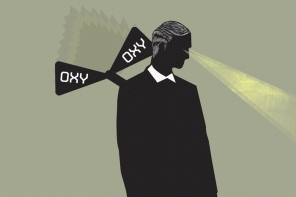In 1996 California was the first state to legalize Marijuana sales to patients with a prescription from a doctor. Since then a dozen more states and millions of patients have smoked, eaten and rubbed medical-grade weed in accord with their doctor’s orders. Between bong rips within a private residence in the states, this California resident illuminates exactly how the California medical cannabis industry works for ordinary citizens and the threat this system faces from the prison lobby and Obama administration.
San Francisco, CA
“My back aches and I regularly suffer from anxiety. I smoke herb from street dealers and do yoga to relieve both, but would prefer to do so legally,” I told the doctor whose eyes held zero trace of skepticism. Her white lab coat swished around her knees as she responded genuinely, “Well that sounds healthy.” 10 minutes later my picture was being taken by the receptionist and 80 American dollars lighter, I emerged from the clinic in downtown San Francisco with a card entitling me to as much medical-grade cannabis from any of the thousands of clubs in California as my heart desires.
I’m a teacher and there’s this small problem the system has with educators of their children being convicted of drug crimes. The funny thing is that many teachers smoke weed with regularity. If you had to teach your 15 year-old child and 30 of their classmates all week long for 9 months, wouldn’t you want to relax with a joint in a park and a book? California’s medical system is perfect to protect professionals in sensitive positions. There are absolutely no moral quandaries among these educators, myself included. No one has ever smoked a joint and beat their wife, but users of alcohol, a legal drug, do so all the time. Users of prescription Ambien fall asleep at the wheel, children are slamming Ritalin cocktails to sit still in class, and miserable Mormon mothers deal with their discontent by popping anti-depressants like Tic Tacs. In light of society’s malignant context, medical weed should be pretty low on the totem pole of social concern.
Walking into the dispensary is like peeling back the curtain in the Wizard of Oz, revealing a tiny green man with tens of marijuana varieties for all types of effect. You can buy THC – the primary psychoactive ingredient in Marijuana – infused into lollipops, lotions for topical treatment, gourmet treats, and lip balm. Everything is taxed, but still reasonably priced. California is known for growing enough produce to feed the entire west, and still, weed is its largest cash crop. Dispensaries have licenses, file tax returns, register with local law enforcement and regularly employee their own guards for additional security. Even the employee at the club has a good chance of having been educated in the industry at one of California’s new Marijuana Universities – can’t make that up. The days of lawless cowboy weed shoot-outs are over.
Or at least they should be, if it wasn’t for the Obama administration ordering the DEA (Drug Enforcement Agency) to raid hundreds of legal clubs across the country. Perhaps the most sensible policy the US government has enacted since the end of the Vietnam war is under siege by the seemingly most reasonable president since JFK. According to federal law, Marijuana is still a schedule 1 controlled substance, in sordid company with LSD, heroin and MDMA. This classification nullifies Obama’s supposed intention to de-emphasize marijuana prosecutions. Clubs in California and other states have been systematically raided, striking fear into the hearts of legitimate, tax-paying, law-abiding, by the books medical marijuana distributors and patients.
The United States incarcerates its citizens in numbers rivaling the most despotic dictatorships. According to the Bureau of Justice Statistics, 60% of the US’s over 2 million prisoners are non-violent drug offenders, of which half are incarcerated on marijuana-related charges. The majority of arrests are poor black and brown folks who are specially targeted by police and lack the means to protect themselves from prosecution. It costs an average $37,000 to incarcerate an individual per year. California spends less than $4,000 per public student per year. Prisons are rapidly being privatized, meaning that those corporations, like the GEO group, are making enormous profits from government contracts to operate prisons packed with non-violent drug offenders. Prisons employ thousands of middle-class guards and command millions of lobbying dollars to maintain the legal status quo. The math is extraordinary: 2 million prisoners X .6 equals 1.2 million non-violent drug offenders. 1.2 million X .4 equals 480,000 incarcerated marijuana offenders. If private prisons were to incarcerate all of these people, they would have a total contract totaling $17,760,000,000. Even more ominously – if that’s even possible – as these corporations grow larger, they are going public and their stocks are traded internationally. This creates a massive, worldwide incentive to continue locking up Americans at record rates.
This is simply unacceptable when we have safe, legal systems in place, already approved by voters that provide a product that tens of millions of people desire and are willing to go through official channels to obtain.







